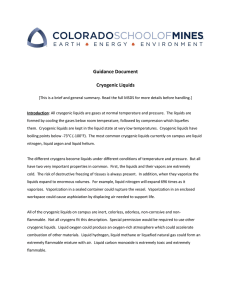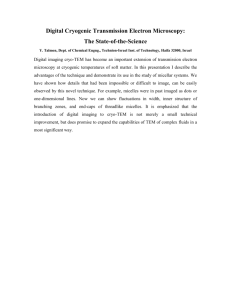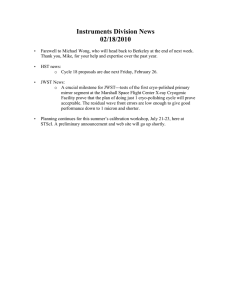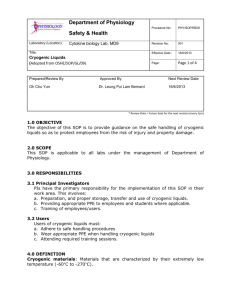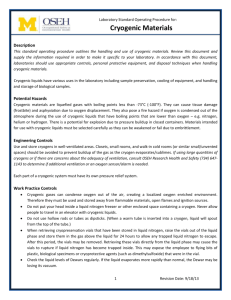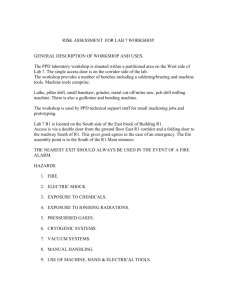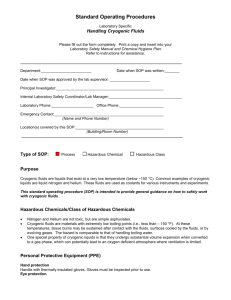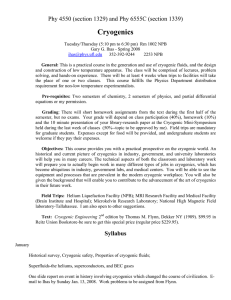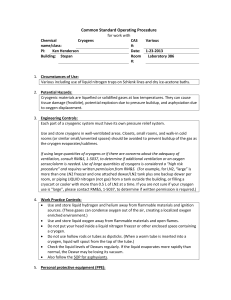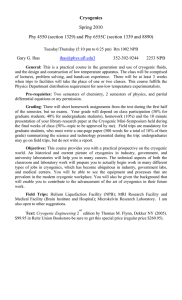Western Carolina University General Use Standard Operating Procedure for Cryogenic Liquids
advertisement
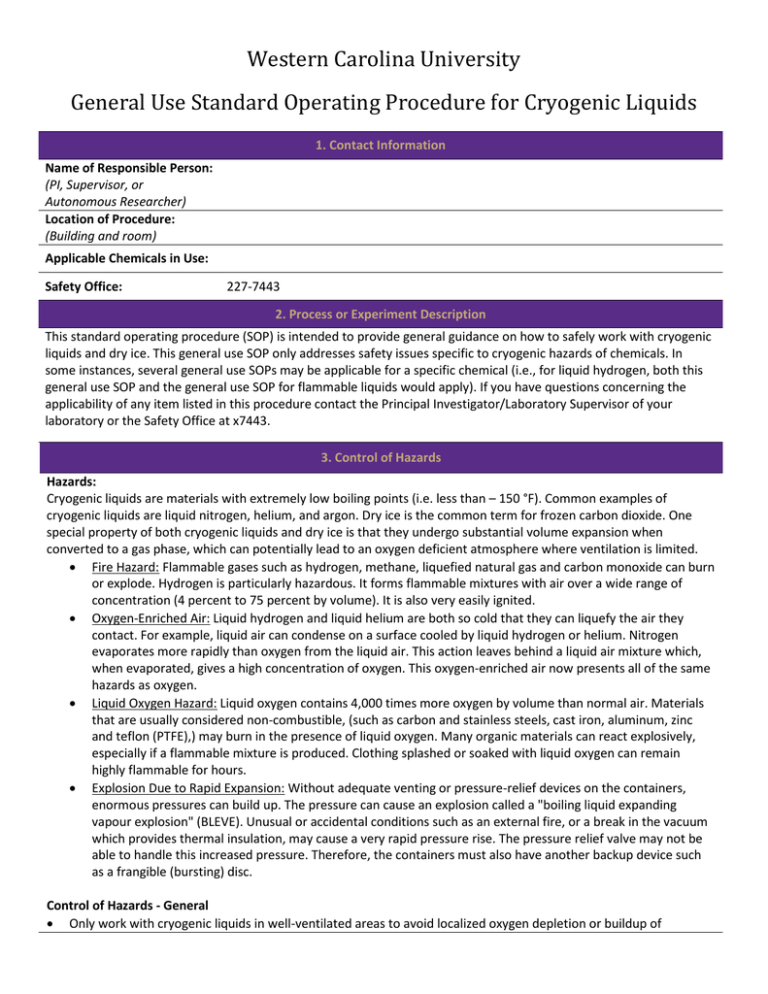
Western Carolina University General Use Standard Operating Procedure for Cryogenic Liquids 1. Contact Information Name of Responsible Person: (PI, Supervisor, or Autonomous Researcher) Location of Procedure: (Building and room) Applicable Chemicals in Use: Safety Office: 227-7443 2. Process or Experiment Description This standard operating procedure (SOP) is intended to provide general guidance on how to safely work with cryogenic liquids and dry ice. This general use SOP only addresses safety issues specific to cryogenic hazards of chemicals. In some instances, several general use SOPs may be applicable for a specific chemical (i.e., for liquid hydrogen, both this general use SOP and the general use SOP for flammable liquids would apply). If you have questions concerning the applicability of any item listed in this procedure contact the Principal Investigator/Laboratory Supervisor of your laboratory or the Safety Office at x7443. 3. Control of Hazards Hazards: Cryogenic liquids are materials with extremely low boiling points (i.e. less than – 150 °F). Common examples of cryogenic liquids are liquid nitrogen, helium, and argon. Dry ice is the common term for frozen carbon dioxide. One special property of both cryogenic liquids and dry ice is that they undergo substantial volume expansion when converted to a gas phase, which can potentially lead to an oxygen deficient atmosphere where ventilation is limited. • Fire Hazard: Flammable gases such as hydrogen, methane, liquefied natural gas and carbon monoxide can burn or explode. Hydrogen is particularly hazardous. It forms flammable mixtures with air over a wide range of concentration (4 percent to 75 percent by volume). It is also very easily ignited. • Oxygen-Enriched Air: Liquid hydrogen and liquid helium are both so cold that they can liquefy the air they contact. For example, liquid air can condense on a surface cooled by liquid hydrogen or helium. Nitrogen evaporates more rapidly than oxygen from the liquid air. This action leaves behind a liquid air mixture which, when evaporated, gives a high concentration of oxygen. This oxygen-enriched air now presents all of the same hazards as oxygen. • Liquid Oxygen Hazard: Liquid oxygen contains 4,000 times more oxygen by volume than normal air. Materials that are usually considered non-combustible, (such as carbon and stainless steels, cast iron, aluminum, zinc and teflon (PTFE),) may burn in the presence of liquid oxygen. Many organic materials can react explosively, especially if a flammable mixture is produced. Clothing splashed or soaked with liquid oxygen can remain highly flammable for hours. • Explosion Due to Rapid Expansion: Without adequate venting or pressure-relief devices on the containers, enormous pressures can build up. The pressure can cause an explosion called a "boiling liquid expanding vapour explosion" (BLEVE). Unusual or accidental conditions such as an external fire, or a break in the vacuum which provides thermal insulation, may cause a very rapid pressure rise. The pressure relief valve may not be able to handle this increased pressure. Therefore, the containers must also have another backup device such as a frangible (bursting) disc. Control of Hazards - General • Only work with cryogenic liquids in well-ventilated areas to avoid localized oxygen depletion or buildup of • • • • • • • • • flammable or toxic gas. Handle objects that are in contact with cryogenic liquids with tongs or proper gloves. Transfers or pouring of cryogenic liquids should be done carefully to avoid splashing. Containers and systems containing cryogenic liquids should have pressure relief mechanisms. Cryogenic liquid cylinders and other containers (such as Dewar flasks) should be filled no more than 80% of capacity to protect against thermal expansion. Cryogenic liquid/dry ice baths should be open to the atmosphere to avoid pressure build up. Keep liquid oxygen away from organic materials and ignition sources. Transfer of liquid hydrogen in an air atmosphere can condense oxygen in the liquid hydrogen, creating an explosion risk. Cryotube thawing - In addition to wearing proper safety equipment, when thawing cryotubes, place the cryotube in a heavy-walled container (e.g., a desiccator) or behind a safety shield to protect yourself in the event that the tube shatters. Shield or wrap fiber tape around glass dewars to minimize flying glass and fragments should an explosion occur. Note: Plastic mesh will not stop small glass fragments. Engineering/Ventilation Controls If the process does not permit handling of cryogenic liquids in a well-ventilated area (minimum of 6 air changes per hour) contact the Safety Office to determine necessity of an oxygen-deficiency monitor. Personal Protective Equipment At minimum, safety glasses, long pants, and closed toed shoes are to be worn when entering laboratories having hazardous chemicals in use. Additionally when handling cryogenic liquids, heavy gloves (e.g., cryogenic gloves), safety goggles, face shield, and lab apron are appropriate. 4. Special Handling Procedures and Storage Requirements. • • • • Cryogenic liquid dewars are to be stored in well-ventilated areas. Storage in unventilated closets, environmental rooms, and stairwells is prohibited. Large dewars must be tethered/ anchored to a wall. Store flammable cryogenic liquids and liquid oxygen away from combustible materials and sources of ignition. Additionally, follow all substance-specific storage guidance provided in SDS documentation. 5. Spill and Accident Procedures Do not attempt to clean up any spill or cryogenic liquid. If a large spill or dewar leak occurs, immediately exit the area and call the Safety Office for emergency assistance 6. Waste Disposal Coordinate w/ vendor for return of dewar(s). 7. Minimum Training Requirements • • Chemical Safety for Laboratories Laboratory-specific training 8. Approval Request Reference the WCU CHP to determine the need for prior approval for high risk procedures. Approval must be granted from the PI and the Safety Office and documented in writing. 9. Decontamination Procedures Contact with cryogenic liquids may cause crystals to form in tissues under the spill area, either superficially or more deeply in the fluids and underlying soft tissues. The first aid procedure for contact with cryogenic liquids is identical to that for frostbite. Rewarm the affected area as quickly as possible by immersing it in warm, but not hot, water (between 102° and 105° F). Do not rub the affected tissues. Do not apply heat lamps or hot water and do not break blisters. Refer to the SDS for any specific instructions. Cover the affected area with a sterile covering and seek assistance at University Health Services. 10. Designated Area For cryogens that are also considered particularly hazardous substances, a designated area shall be established per the other applicable SOP(s). General Use Standard Operating Procedure for Cryogenic Liquids “I have read and understand this SOP. I agree to fully adhere to its requirements.” Last Name (print) First Name (print) 92# Signature Date
